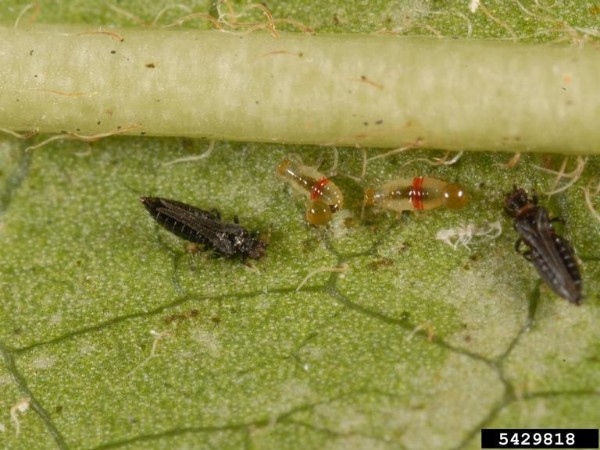Thrips
Thrips are generally very small (up to 2 millimeters (mm), or 1/10 inches, in length) and their colors range from pale yellow to black. Some predaceous species are brightly colored. Correct identification to species level can be made only under magnification or with the help of an expert. The life cycle of thrips consists of the egg stage, followed by two larval stages, two pupal stages, and finally the adult stage. Males are generally smaller than the females. Thrips display parthenogenesis (reproducing without mating), and both mated and unmated females can lay eggs. The eggs of most plant-feeding thrips are inserted into plant tissue by the females. The larval stages actively feed on plant material.
Many of the thrips species are polyphagous, feeding on a variety of unrelated plants. Flower thrips, chilli thrips, and red-banded thrips are reported from hundreds of plants including trees, ornamentals and vegetable crops, field crops, and weeds. Greenhouse thrips are widespread on most greenhouse-grown crops but are also seen attacking outdoor plants in warm weather. Gladiolus thrips are mainly seen on gladiolus flowers and corms. However, they have been recorded (but not successfully reared) on other plants such as Philodendron spp., Clitoria spp., and Rhododendron spp. Melon thrips are polyphagous but are primarily known as pests of cucurbits and solanaceous plants. They also attack other vegetables such as beans, peas, cabbage, and lettuce; ornamentals such as carnation, chrysanthemum, hibiscus; and trees such as avocado, peach, and plum. Cuban laurel thrips are mainly found on ficus, Ficus retusa L. being their preferred host. They are reported to feed occasionally on eucalyptus and orchids.
The mouthparts of thrips are unique to their family and asymmetrical, unlike those of most insects. The left mandible forms a narrow stylet that draws out plant sap, and the right mandible is reduced or absent. The feeding mechanism may be described as “punching and sucking,” through which the plant surface is rubbed to break the surface and the exuding sap is sucked up. Some species inject digestive enzymes into the wound, and this causes silver or bronze colored speckles on the surface of the plant parts. Small black specks of excrement may also be seen on the affected parts. Some thrips also excrete honey dew, which favors the growth of black sooty mold.
Thrips may feed on leaves, flower buds, flowers, or fruit, depending on the species. Thrips damage causes discoloration, distortion, premature drying, and shedding of leaves, flowers, and buds. Feeding can also impact a plant’s ability to grow, causing stunting or dwarfing. Infested fruits are discolored, deformed, and scabby. Corms and bulbs turn soft and susceptible to decay.
Thrips are attracted to the colors yellow and blue, so yellow and blue sticky cards are an effective way to monitor populations. The cards should be placed among plants just above the canopy level so that the insects are caught during flight. Blue or white water pan traps can also be used for monitoring. Regular inspecting plants for damage symptoms, like silvery or bronze discoloration, and the distortion of leaves and flowers will also help to identify damage from thrips.
Gently tapping affected plant parts onto a white sheet of paper dislodges the thrips. Samples of affected plant parts should be collected and placed in sealable plastic bags and sent for correct identification. Using indicator plants that are more attractive and susceptible to thrips than the primary crop may provide an early indication of thrips infestation. For example, petunias are useful indicators of western flower thrips infestation.
Several species of thrips attack landscape, nursery, and greenhouse plants. The correct identification of the species may become necessary to properly manage the pest. Sometimes, thrips species occur on different host plants but may not cause significant damage and treatment may not be necessary. An integrated approach is always best to manage thrips, and the sanitation of the field area or greenhouses is integral to thrips management. Weeds may serve as alternate hosts for thrips as well as reservoirs for viruses. Fallen leaf litter or debris should be removed to reduce pupation rates and disrupt population buildup.
Physical exclusion can help prevent infestation. Placing fine mesh screens over fans and other vents restricts the entry of thrips. Mesh screens can also be used to restrict small areas of nurseries to prevent thrips from attacking new plants or to examine and quarantine plant material brought from outside. Greenhouse workers should avoid wearing bright colored clothes, especially when moving between greenhouses, so that thrips are not attracted and transported.
Most thrips are attacked by one or more natural enemies and chemical control may not be required in certain situations, especially in the landscape. For example, red-banded thrips and melon thrips are preyed upon by lacewings, spiders, predatory thrips, mites, and predatory bugs like minute pirate bugs. Some natural enemies are specific, like the larval endoparasitic wasp Thripobius semiluteus Boucek (Eulophidae), which specifically attacks greenhouse thrips. Biological control of thrips in greenhouses and high-value landscapes and nurseries can be successful only if it is part of integrated management program.
Chemical control often becomes necessary in severe infestations, but it is important to understand that thrips are difficult to control due to several reasons. Owing to their tiny size, they can hide in places that cannot be reached by pesticides. Systemic insecticides also have limitations, because they may not reach growing points of plants like tender leaves and buds where the thrips feed. The continuous exposure to insecticides leads to the development of resistance in thrips. Therefore, the choice of insecticides and their application methods should be made after considering these points. Insecticides should be used sparingly if the damage is tolerable and natural enemy populations are high. Using the Georgia Pest Management Handbook, choose insecticides labeled for use against thrips and for application on the host plant. Contact your local University of Georgia Cooperative Extension office for specific recommendations. Follow all directions, particularly safety precautions on insecticide labels.




